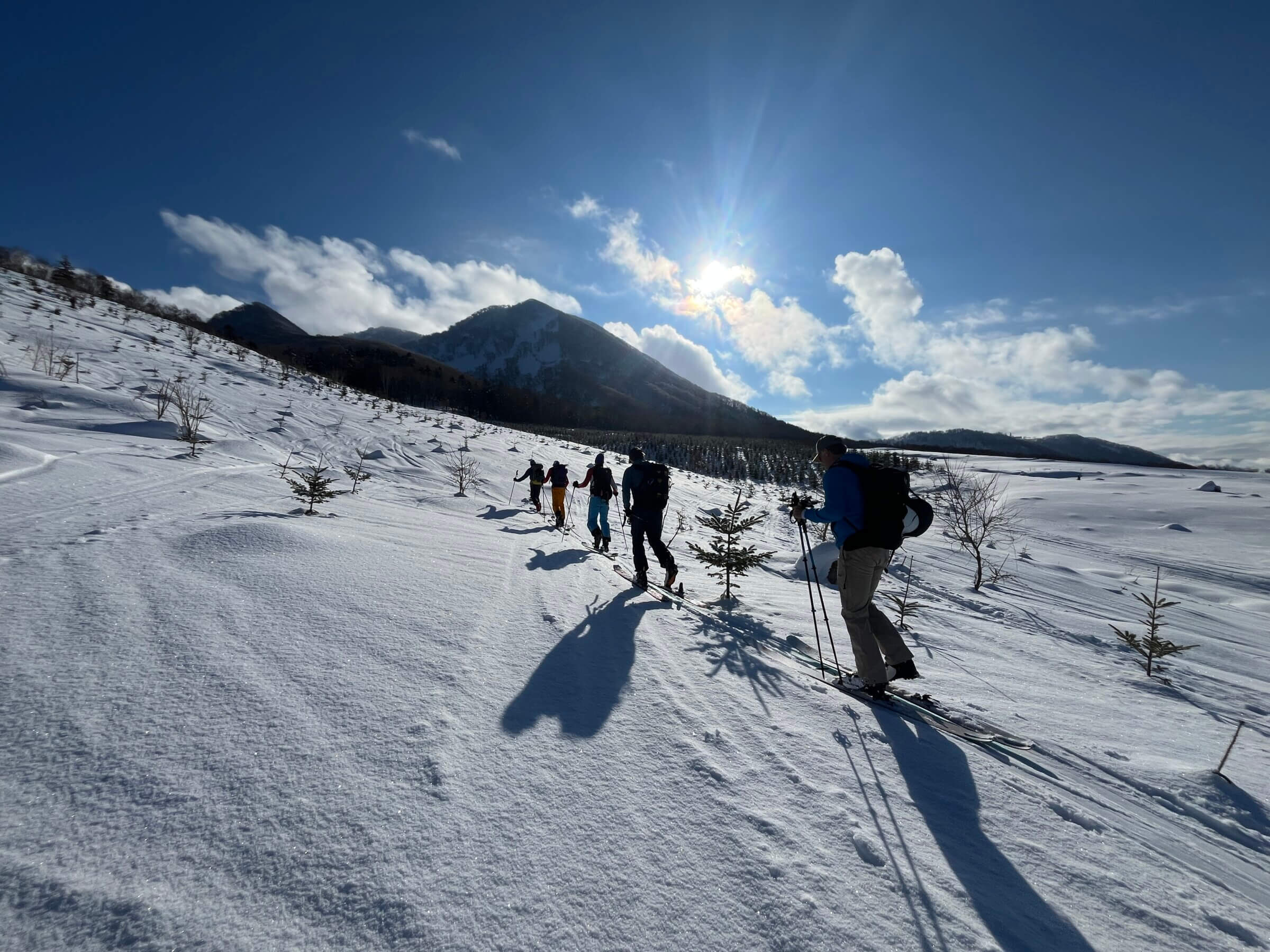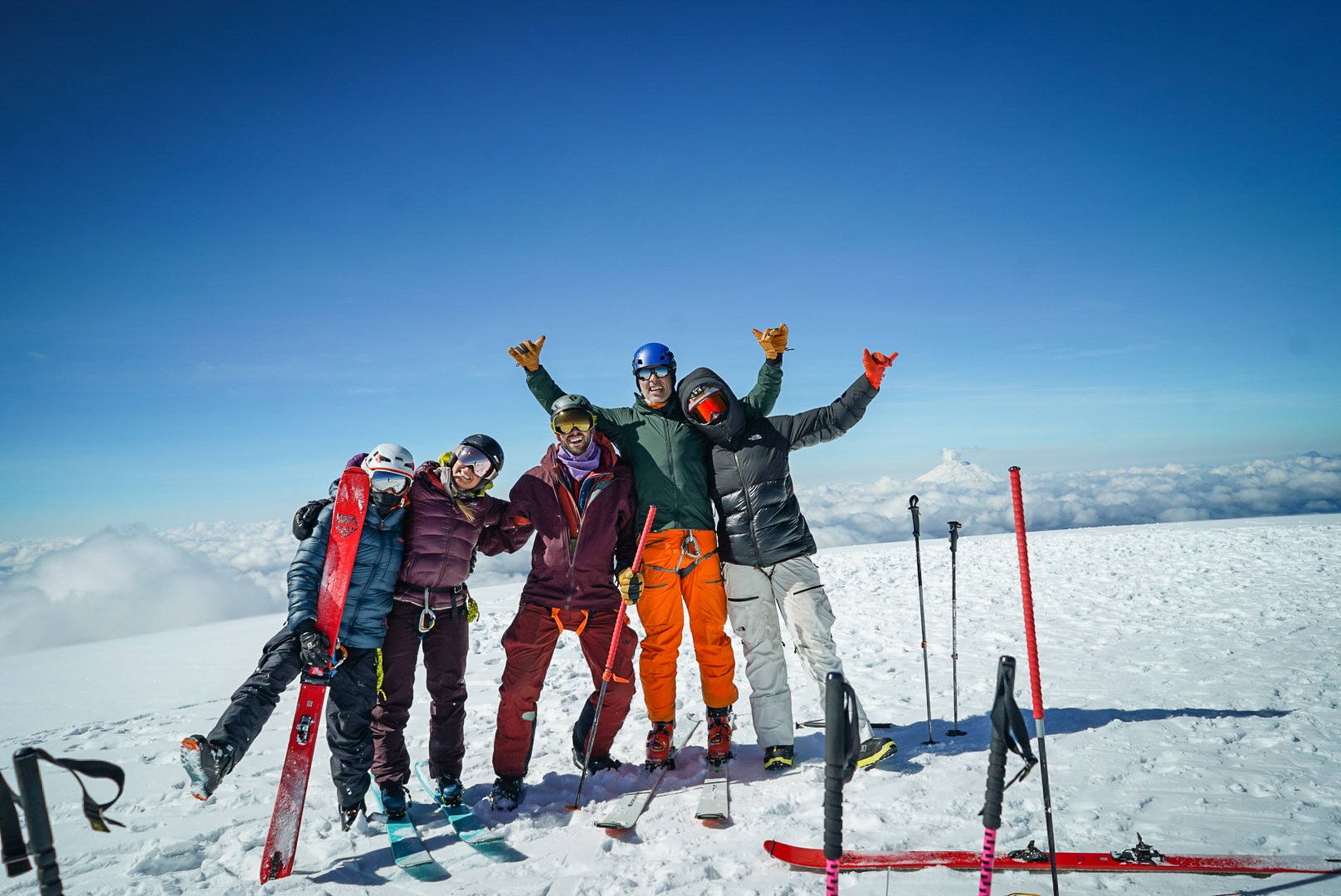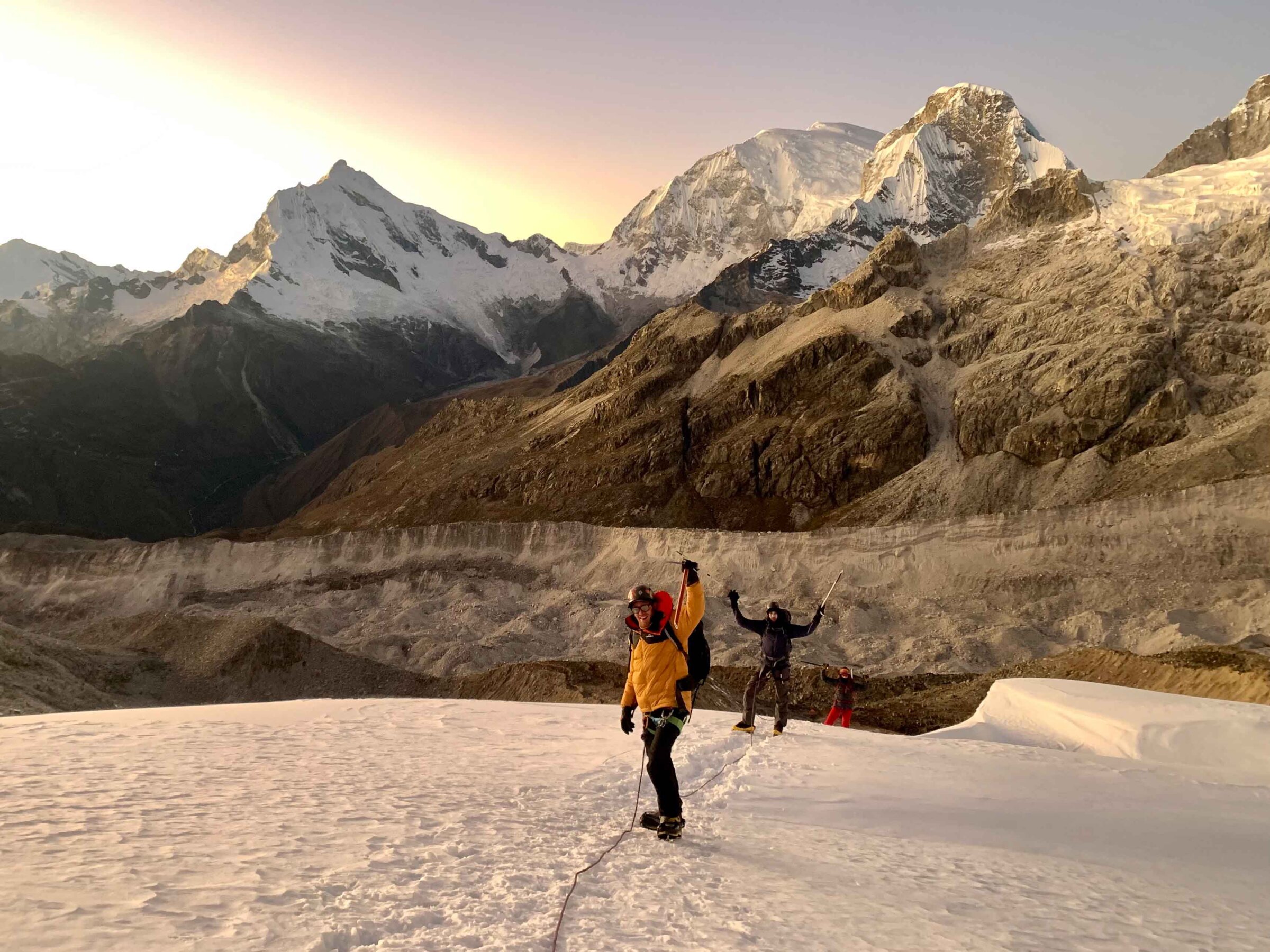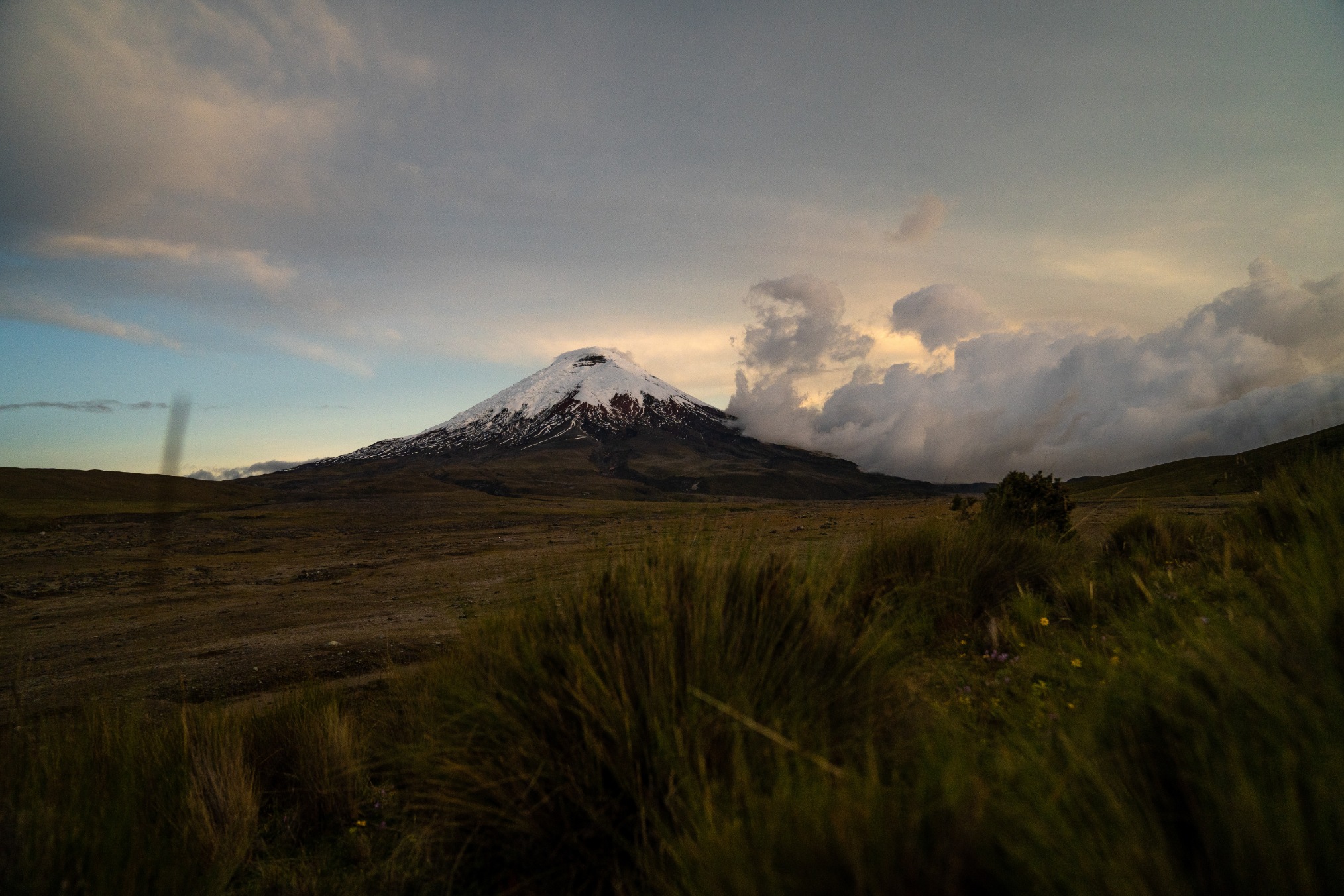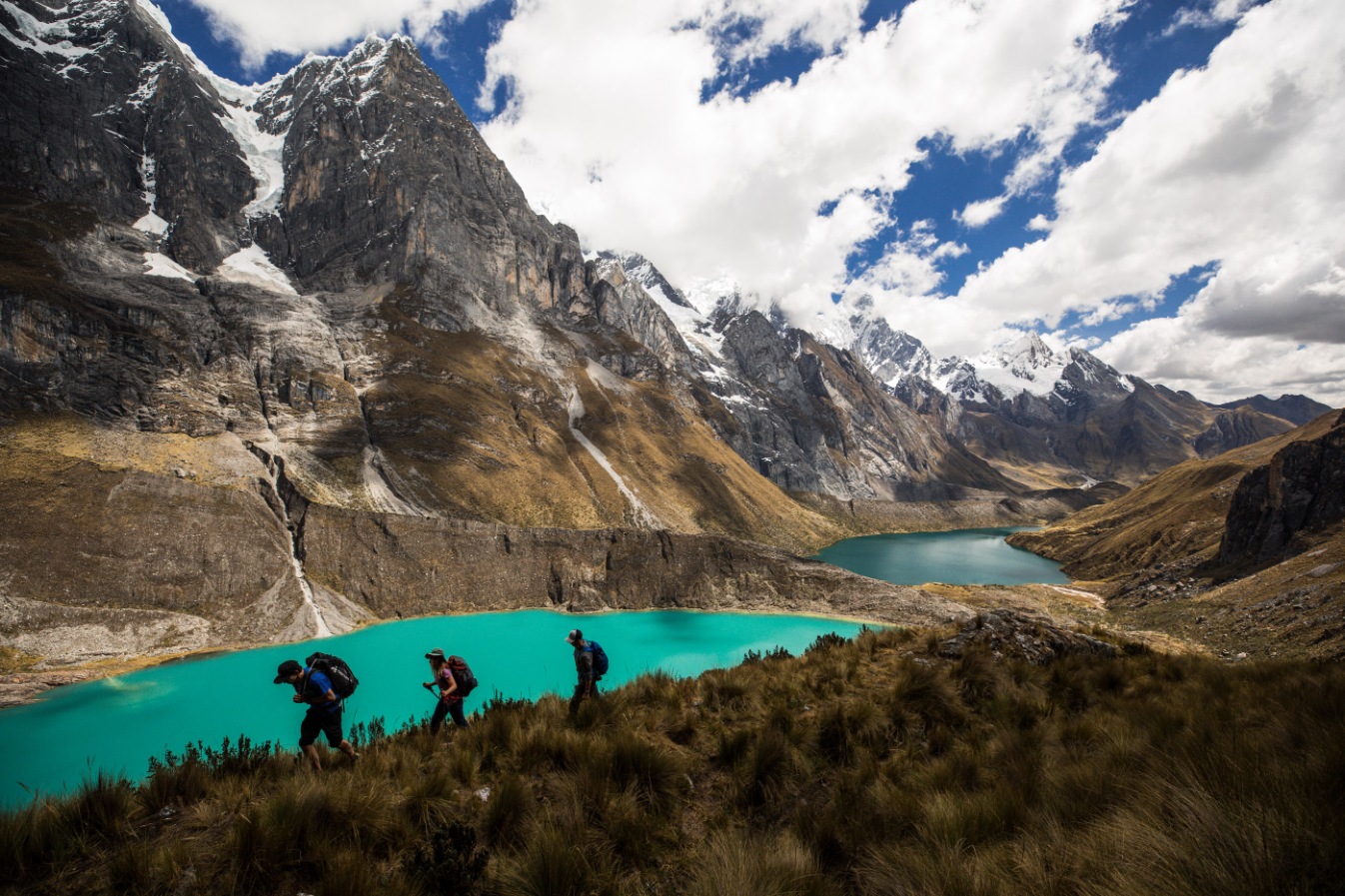The Star Mountain: A Detailed Account of Climbing Pico de Orizaba

Before the Climb
“Rob, come outside. You should see this.”
Phil called to me from where he stood on the metal staircase adjacent to the kitchen, looking east and pointing toward something I couldn’t see. Inside, the family hosting us were busy making dinner. The muffled sounds of clanging metal, vegetables sizzling in an iron pot, and of wet brushes scraping against wood broke through the quiet evening in the rural Mexican village of Tlachichuca.
Tlachichuca sits at the convergence of multiple ecosystems: on the border of the Mexican states of Puebla and Veracruz, coniferous forests at higher altitudes become broadleaf, subtropical forests at lower elevations. A shrubby patch of desert crawls up from the south. In spring months, mornings are balmy and cool. Visibility diminishes as the sun climbs higher, until afternoon storms blot out the horizon. Vast sheets of dark gray rain wash over the land, visible from many miles away. As the sun falls, its color intensifies from soft white to muted shades of orange, amber, and scarlet. For its final act, the last burning rays melt away any lingering strands of fog, and the many volcanoes of this region become striking black pyramids that thrust upward from an otherwise flat, uniform landscape. Evenings are bathed in a dusky cornflower blue. As the skies clear and the stars begin to pierce the veil of dissipating storms, there is a fleeting moment where the unique features of these volcanoes become visible. Sprawling forests encircle their bases before coming to an abrupt end at 13,000’, where swathes of stone and sand climb higher before surrendering completely to fields of volcanic rock. Glaciers flow from a few of these summits. Columns of vapor and sulfuric gas billow from their craters, so that every glance offers a new rendition of a place that feels dormant, but very much alive.
On bare feet I padded over cool concrete and up the stairs to where Phil was perched. Again he pointed, and I turned to see one of the black pyramids now illuminated by the rising moon. For the first time since our arrival in Mexico, the mountain revealed itself, a vision as beautiful as it was daunting. It filled me with adrenaline, exhilaration, and the dread of anticipation.
At 18,491’, Pico de Orizaba (Citlatépetl by its indigenous name, meaning Star Mountain) is the tallest peak in Mexico, and the third-tallest in North America. Tlachichuca is at the base of the volcano, and so the sheer size of it from up close was astonishing: a massive white cone, glowing in the last light of day, atop a trapezoidal heap of rock, sand, and ash accumulated over millennia. In under 24 hours, we’d be hunkered down at 14,000’ in a rudimentary hut on the flanks of the volcano before making an attempt on its summit.
I snapped a few photos, Facetimed my parents to show them what their son was about to do, and went down to the kitchen to help out with dinner. The planning and preparation phase was over. We were packed and ready. The only thing left to do was climb.
Piedra Grande
A two-hour drive from Tlachichuca to base camp took us through flatlands and farm villages. At the edge of the forest, the road changes from mostly-paved to completely impassible without a 4×4 off-road vehicle. Our driver silently navigated a maze of boulders, runnels, and gullies until, about 200 yards from the hut, the car overheated and broke down. We divided roughly 100 pounds of gear and 16 liters of water between 3 climbers and began plodding up the road toward base camp. At 14,000’, each heavy-laden step was laborious and draining. I arrived at the hut winded, but grinning.
The driver was able to cool the engine with some of our water before heading back down to Tlachichuca. I never saw him leave, but as soon as I noticed he was gone, a sense of remoteness and isolation fell over the place. April is well outside of the regular climbing season on Pico de Orizaba, as it is more prone to storms. We were the only team on the mountain.
At the edge of the trailhead sits the Piedra Grande (Big Stone) Hut. It is little more than four stone walls, a red aluminum roof, and a heavy wooden door that doesn’t quite close all the way. Inside are two tables and three tiers of wooden platforms for sleeping. The walls are etched with the signatures of generations of climbers from California to Kamchatka.
About halfway up the road, we realized we’d brought plenty of food, but no stove. Our bags of uncooked rice were now little more than dead weight. Laying everything out on one of the tables, we were confident that we had enough calories for the climb, however unpleasant it would be to consume them. For dinner, I spooned down a bag of ice-cold refried beans with chunks of avocado and crushed rice cake, topped with garlic salt and Cholula hot sauce. While I mixed mine around in a bowl, Bryce ate his beans and avocado straight out of the bag.
He’d wolfed down a can of tuna before this. For the sake of calories, I tried a bite, and with considerable effort kept myself from heaving. The smell alone was pungent and repulsive, not to mention the fleshy, wet, chewiness that only processed fish submerged in cloudy, viscous water can offer. Phil was having none of it, resolving himself to a PB&J and some other snacks we’d brought.
Whether it was the altitude, anticipation, shared mannerisms of close friends, or the comedy of resolute destitution, we cackled at the situation. Our hoots and hollers, heard by no one, were carried off in the wind. The sight of our dinner alone, with each of us watching as the other would grimace at every bite, was enough to send us rolling all over again. We’d chosen to be here. This was fun for us. We sat shivering in the wind and laughed until tears rolled down our cheeks and into our beans.
The setting sun bore witness to a brief self-arrest clinic in preparation for the climb. Phil and Bryce watched as I lay face down on a sandy slope, explaining how self-arrest works most of the time with proper technique, but that it’s generally best to avoid falling if at all possible. Back inside, I stuffed my pack with safety and rescue equipment, extra layers, food, water, first aid, crampons, an ice ax, and my camera. I stashed it on the upper sleeping platform to deter the mice, who’d grown bold in the shadows, from gnawing through the fabric.
The Moraine
As it turned out, the mice had no qualms with getting close. Mere minutes after lying down, a startled shout from Bryce indicated that one of them had made its way into his sleeping bag, prompting our hasty retreat to the upper level. As we’d made the jump from 8500’ in Tlachichuca to 14,000’ at the hut, ‘sleep’ devolved into four or five hours of lying still with my eyes closed, interrupted by a few short and fitful naps. I felt something like relief when the sound of the alarm finally punched through the darkness. It was 1:30am.
I gulped a liter of water and choked down half of a very dry, half-frozen granola bar. By 2:15 we were on the move, using spray-painted trail markers and rough-hewn cairns to guide us upward through the night. Almost 3,000’ of elevation gain lay between us and the toe of the glacier. Much of this time passed silently, with conversation largely restricted to route-finding and water breaks. A handful of slick, icy rock scrambles through no-fall zones kept us alert as we plodded through a labyrinth of sand, loose rock, and eventually snow for the better part of four hours.
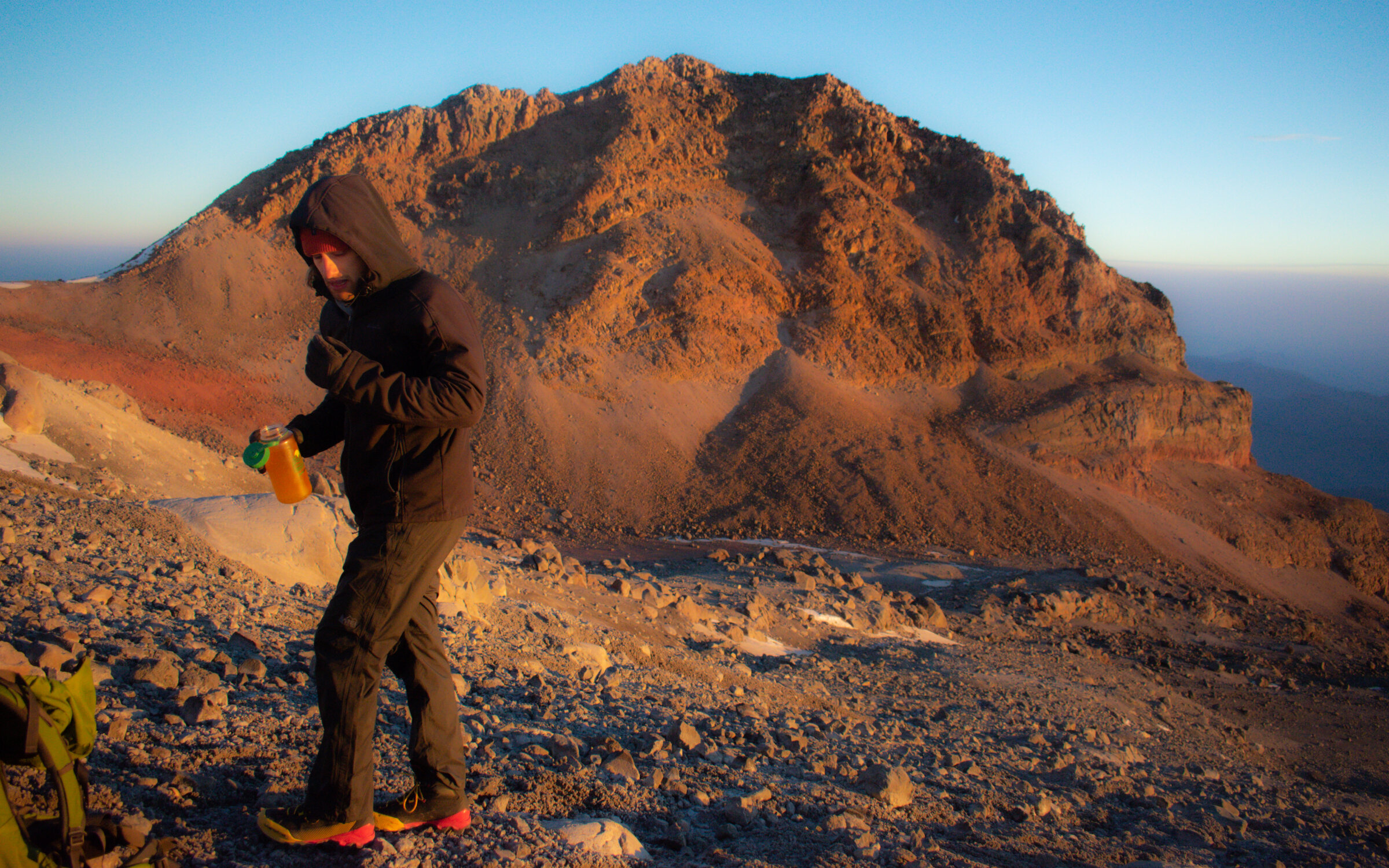
Sunrise and clear skies greeted us at the glacier’s edge. We agreed that hiking through the dark had actually done us a favor, as it obscured the true size of the mission before us. I stopped to snap some photos of the morning light against the east face of Orizaba while Phil and Bryce climbed onward.
Ahead, I saw the other two stopped at the foot of the glacier. I arrived, revitalized by the sun and stoked to feel so close to the summit, when Phil announced that he’d just emptied the contents of his stomach.
“Snickers got me,” he explained. “I feel okay now, though.”
I was concerned, but unsurprised. Everything up until this point had gone supremely well. We’d reached nearly 17,000’ without much of a hitch, and though our good fortune thus far was encouraging, it also aroused suspicion. Bryce and I divided the weight of Phil’s pack and offered extra layers, leaving him to carry only the bare essentials. Still, his condition gave me pause.
From a guide’s perspective, symptoms of AMS (acute mountain sickness) are alarming and cause for descent. The only way to relieve altitude sickness is to go down, and as a leader obligated to do what’s best for clients, it is a guide’s responsibility to make the often-disappointing decision to turn around.
But as a recreational team, there is room for discussion. Years of sufferfests with Phil have shown me that he is incredibly capable in the face of adversity. In October 2022, after a difficult and scary lead on Pitch 3 of Epinephrine (5.9, 1600’), Phil had every reason to bail. Instead, with 1200’ still yet to be climbed, Phil handed me the sharp end of the rope and insisted that we continue up. Eight hours later, we were on top of Black Velvet Peak, looking out over the vast expanse of desert that surrounds Las Vegas. This is the type of confidence and trust born from experience that forms the foundation of a healthy partnership. When Phil says he’s okay, I believe him.
The Glacier
With ice axes in hand and crampons attached, the three of us began a slow, methodical ascent up the glacier. The snow was crunchy and rotten, overlying a base of firm, cloudy ice. Each step required that we kick in our toe spikes and lurch upward. Stiff-soled boots on high-angle terrain made for awkward movement. My stoke about being back on a glacier died down quickly, and after 45 minutes of solid effort, I made the mistake of looking back to find that we’d barely gained 500’ of elevation. Soon after, the summit above us turned out to be a false one. Behind me, Phil groaned audibly with each step as he battled nausea and fatigue.
The landscape on the upper mountain was uniform and featureless. A sea of steep white vaulted upward in front of us toward a true summit we still could not see, making the ascent feel infinite and progress futile. I did my best to focus only on gathering strength for the next step, knowing that every foot higher we climbed would only render my breaths less restorative. At 18,000’ above sea level, oxygen in the atmosphere is reduced by 50%, and I could feel my body weakening and my mind growing dull.
A splashing sound let me know that Phil was once again heaving up what was mostly water at this point. I turned around to see him doubled over a dreamsicle-colored puddle. Dry heaves racked his diaphragm, folding him against the snow. The altitude was taking its toll, and my concern grew.
“I think …”, he said, struggling to get the words out. “I think … you and Bryce … should summit without me.”
I knew this was coming, as well as he knew the answer: “Sorry Phil, that’s not an option. We can’t leave you here,” I answered.

Phil was exhausted, eyes closed, laying face down over his pack. His mouth was mere inches from the surface of the glacier, and I could see his back expand and contract with short, rapid breaths. I listened for any wet, crackly sounds from his lungs that might indicate the onset of HAPE (High Altitude Pulmonary Edema), but heard none. His breathing was clear, albeit labored, and as he had yet to exhibit any signs of an altered mental state, I felt confident in ruling out HACE (High Altitude Cerebral Edema) as well.
At 17,500’, we were six hours into a climb for which we’d barely acclimatized, running on just a few hours of poor-quality sleep. Nausea, headache, increased heart and respiratory rates, and deep, internal dialogue about why the hell we were up here—all symptoms I was starting to feel myself—were to be expected.
A hundred yards ahead and seemingly blessed with altitude immunity, Bryce sent down words of encouragement. Though his pace slowed considerably throughout the glacier climb, he was outwardly unaffected by the thin air, sub-freezing temps, and steep ascent.
“We’re about 900 feet from the summit,” he shouted. “That’s three more pushes!”
I looked down at Phil and asked, “Did you hear that? Just three more pushes, man. If you want to turn around, say the word and we’ll go, but we’re not summiting without you. What do you think?”
Phil continued to breathe heavily. I could tell he was thinking about it, but when he looked up, I was thrilled to see that he was smiling.
“Yeah,” he said. “Okay. Let’s do it.”
The Summit
“Alright,” I replied. “If you change your mind, you say something, okay?”
He nodded, and I turned to wave the go-ahead up to Bryce. Phil stood up. His mouth was agape, sucking in what oxygen he could in between grimaces of determination and pain. Digging in with the hilt of his ax, he took one step, then another, and we continued up through an ocean of snow and ice.
As the sun warmed the surface of the glacier, rollerballs tumbled down on either side of us. Although the temperatures were hovering around 0℉, the sun burned hot against my nose, cheeks, and mouth. Reflection off the snow surface offered no respite from its rays, powerful and unrelenting at high altitude. Through cracked lips and a tongue that felt sandy and swollen I gasped at cold, thin air. Phil followed my trail, involuntary groans of exertion and exhaustion escaping him with every other step.
Looking ahead, I saw Bryce sitting against his pack on the slope. I looked back to Phil and pointed. With a feeble head nod, he agreed to continue pushing up to Bryce, where we’d break for water.
“2 more pushes,” said Bryce. “About 700 more feet or so.”
The steepness of the glacier made it so that a ten or fifteen minute push gained us around 300 feet of elevation. At this point, I was feeling weak, lethargic, and heavy. The weight of my pack pulled against my shoulders, and my legs quivered in the way they do after a long run. After five or ten steps, I was collapsing to my knees to breathe, putting most of my weight on my ax and looking back to keep eyes on Phil.
Leading up to the climb, I had plenty of time to think about the task that lay before us. In the days before departure, it became all I could think about. My thoughts swam with every possible scenario. I had given the green light for this expedition with two close friends, people with families and worried parents, and for whom I personally cared a great deal. This responsibility weighed heavily on me. More so than thoughts of getting myself to the top, this sense of obligation to make the right choice and keep my friends safe pervaded my headspace as we climbed higher.
Ahead, I heard something like a gleeful shout that could have only come from Bryce. I paused, before another sound came muffled by the wind. Finally, I heard Bryce’s voice ring clear.
“Let’s go!” he yelled.
I’d been staring at the ground for the last ten minutes, only breaking my aimless gaze to occasionally glance back at Phil who trudged behind me, slow and steady. At Bryce’s exclamation, I looked up to see him seated, grinning ear to ear. He was surrounded by dirt, which I thought was odd, until I peered behind him. We were 50 feet shy of the summit.
Until then, my entire world had been reduced to a high-altitude dichotomy of deep, space-like blue and piercing white. Snow and sky were all that lay before me in my tunneling field of vision. Stepping forward, my crampons caught on my pants, and I fell down on all fours. Something between a laugh and a sob escaped me.
To my surprise, Phil saw the end of the road and raced ahead to meet it. I grunted a few words of encouragement to myself and began crawling after him through the frigid sand. Clouds billowed to the east, hugging the summit and spilling over the crater’s edge. Cresting the ridge, we stopped for a moment to shed our packs before walking the final 30 yards to the true summit. There, a statue of the Virgin Mary sat upright on a stone pedestal, wrapped in the Mexican flag. After nearly eight hours, we’d reached the true summit of Orizaba.
After sharing a celebratory embrace with Bryce, I pulled out my phone to take a summit video. In most cases, I’ll use these to verbally document where I am and say a few words about the climb or the conditions. On the summit of Orizaba, due to some combination of emotion and exhaustion, I was speechless.
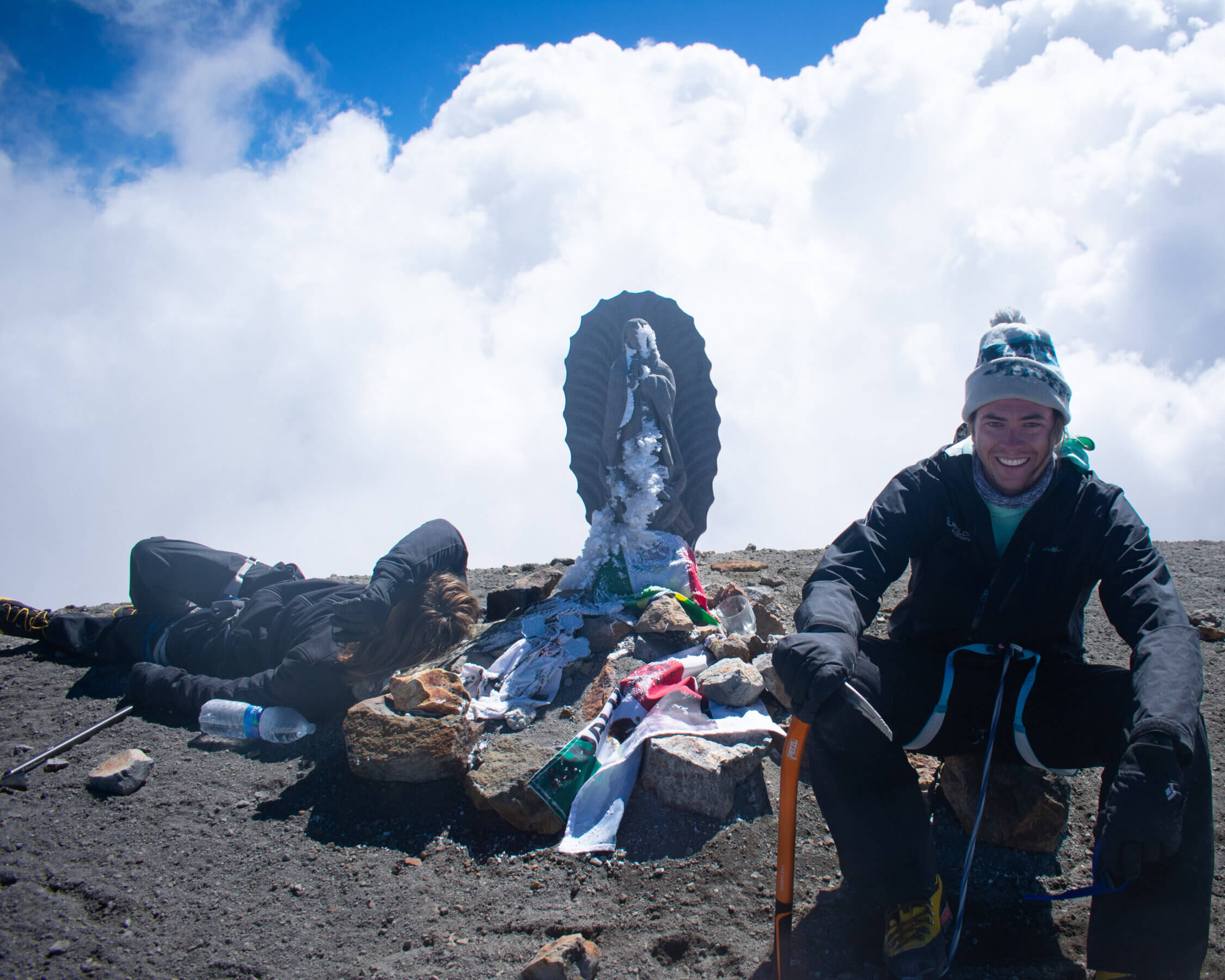
The Descent
It seemed that my loss for words was shared, albeit for different reasons. Reaching the summit of Pico de Orizaba as an unguided, independent team was a massive step forward for me, both personally and professionally. Bryce knew as much, looking on and allowing me the space to quietly experience the emotion of this achievement. Phil, too, was silent, but only because it had taken everything in him to get here, and he was no longer interested in speaking. He was on his back in the dirt, head propped against the statue with one forearm shielding his eyes against the sun. He later admitted to having little recollection of the views from the summit, or that the statue had even been there. Approaching weather motivated a quick departure.
The descent was, like the rest of the climb, both comical and intense. The glacier was steep enough to allow us to remove our crampons and butt-slide most of the way. A soft upper layer of melted snow reduced the concern of gravity-propelled glacial sodomy, though I’d have to dislodge my harness from the inner crevices of my groin every few hundred feet. Occasional sharp chunks of ice opened tiny holes in the seat of my pants, letting water in and leaving me soaked by the time we reached the bottom. I didn’t care.
Clouds chased us down, engulfing the summit behind us in rolling stacks of shadow and blight. It was as if the mountain was saying “Alright, you guys made it. Time to go.” Nausea and headache were now in full effect, but I was giddy with relief. We’d done it.
Eager to descend quickly in the hope that his symptoms would lessen, Phil reached the end of the snow before Bryce and me. My boots squelched in the sticky, half-frozen mud that oozed out from beneath the glacier. Just a few hours prior, this had been a dry, barren expanse. Snowmelt gushed around us now, creating miniature streams and a chorus of rushing water.
I tried to eat the other half of the granola bar I’d stashed away around 2 o’clock that morning, but my body utterly rejected the intake. Half-chewed globs of nuts and chocolate fell from my mouth. Soon I was doubled over the rocks, splattering chunks of granola and the liter of water I’d just chugged into the brown-gray river of snowmelt forming beneath me. Phil and Bryce looked on with concern, made worse when my feet gave way and I slipped, plastering myself with mud like a pig. I heard their stifled laughter, and let one out myself thinking of how defeated I must have looked.
“Let’s uhh … let’s go down, yeah?,” I said, wiping the mud and vomit from my face. We shed layers, packed our bags, and began our descent. After three more hours of stumbling through loose rock and sand, we arrived at Piedra Grande where our driver awaited us.
Our belongings remained in the hut just as we’d left them. Devoid of the meticulous organization that preceded the climb, I stuffed everything I could into my pack with reckless abandon. Outside, I found Bryce sprawled in the dirt behind the trunk of the car. In the few minutes I’d spent amassing our gear, he’d fallen asleep on the ground, his belongings scattered in a circle around him.
I looked down at him, amidst pride and exhaustion, thinking his dirt nap was well-deserved. He stirred when I stepped over him to toss our things in the car. Two hours later, we were back in Tlachichuca beneath a soft, white sun.
Click HERE to learn more about the Volcanoes of Mexico expedition, and click HERE to schedule a meeting with our team.
